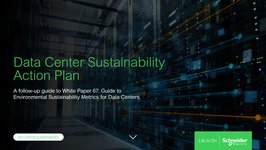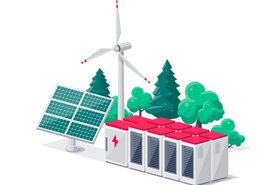Schneider Electric has published a framework document, designed to help data center companies to report on their environmental impact, and assess their progress towards sustainability.
The White Paper goes beyond the data center industry's normal focus on PUE (power usage effectiveness) and sets out five areas to work on, and then lists a number of metrics within those areas, so operators can determine whether they are in three stages of sustainability - Beginning, Advanced, or Leading.
Looking beyond PUE
"As an industry, we need to get together and agree on certain parameters in those five impact areas," said Pankaj Sharma, EVP of Schneider's secure power division, in an interview with DCD. The five areas listed in the report are energy use, greenhouse gas emissions, water use, waste management, and land use and biodiversity. "Those five impact areas are important to consider now. I'm not saying you follow what is in this White Paper. If it doesn't work for you, let's collectively work together - and agree that we have to look beyond PUE.
“Environmental sustainability reporting is a growing focus for many data center operators," said Sharma. "Yet, the industry lacks a standardized approach for implementing, measuring, and reporting on environmental impact. Our intention with this framework is to improve benchmarking and progress toward environmental sustainability to protect natural resources for future generations."
Schneider says that companies are getting pressure from investors, customers, and employees to improve their sustainability, but often don't have the expertise. The company's Energy Management Research Center pulled together expertise from sustainability consultants, data center scientists, and data center architects to make a checklist of goals on the sustainability pathway.
The company hopes the paper will help companies choose how to measure their progress, set priorities, and communicate well within teams and to the outside world. Schneider hopes the scorecard will be the basis of regular reporting and could serve as a standardized benchmark.
The document starts by setting out five areas to work on, and says that "not all data center companies are at the same place in their journey".
"Beginners" should just look at energy use, greenhouse gas emissions, and water use, while those who have become more "Advanced" should add in waste management, and those who want to be "Leaders" must also act on land use and biodiversity.
There's more detail than that. In each area, the report suggests metrics for those at each stage and then maps those onto any existing standards.
The framework reckons that all data centers should be concerned with their energy consumption, their power usage effectivness (PUE), and their renewable energy consumption. To become "Advanced", they should also measure the proportion of energy that is renewable (labeled the Renewable Energy Factor or REF); to become "Leaders" they should be reusing waste heat, measured by the Energy Reuse Factor (ERF).
Similarly, when totting up their greenhouse gas (GHG) emissions, Schneider says data centers should start with Scope 1 (their own emissions) and Scope 2 (emissions from their electricity), before moving on to Scope 3 (emissions from their supply chain).
They should also measure carbon intensity, with a goal of ultimately matching their carbon emissions hour-by-hour.
Water usage and waste have similar sets of goals and metrics, marking how well the company is reducing its use of water, and cutting the amount of waste it sends to landfill. However, Schneider doesn't expect companies to deal with waste going to landfill until they are at the "Advanced" stage.
The paper also lists existing reporting and certification systems, including Energy Star for data centers, and BREEAM for buildings.
"The data center industry has made significant progress in increasing energy efficiency; however, as digital demands increase they must remain committed to driving long-term broader sustainability initiatives,” said Rob Brothers, program vice president for the data center and support services program at analyst firm IDC. "You can’t have an impact on what you don’t measure; therefore, companies must establish clear and consistent metrics that account for not only efficient technology, but also the consumption (or possible destruction) of natural resources such as water, land, and biodiversity.”
More in Sustainability
-

-

Sponsored New fuels of tomorrow
-


